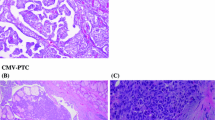Abstract
Background
Cribriform-morular variant of papillary thyroid carcinoma (CMV-PTC) is rare; it may occur in cases of familial adenomatous polyposis (FAP) or be sporadic. To clarify the clinicopathological features of CMV-PTC, the medical records of these patients were investigated retrospectively.
Materials and methods
Between 1979 and 2016, a total of 17,062 cases with PTC underwent initial surgery at Ito Hospital. Of these, 30 (0.2%) cases histologically diagnosed with CMV-PTC were reviewed.
Result
The patients were all women, with a mean age at the time of surgery of 24 years. Seven (23%) cases were thought to have FAP because they had colonic polyposis or a family history of FAP or APC gene mutation. The remaining 23 (77%) were thought to be sporadic. Multiple tumors were detected in 6 cases, with a solitary tumor in 24. One patient had lung metastasis at diagnosis. Eleven patients underwent total thyroidectomy or subtotal thyroidectomy, and 19 underwent lobectomy. Twenty-six (87%) patients underwent neck lymph node dissection. Three patients had tumor metastasis in central lymph nodes, but these were incidentally detected metastatic classical PTC (cPTC) based on histological examination. In this series, there were no cases of LN metastases of CMV-PTC. During a mean follow-up of 15 years, one patient had new cPTC in the remnant thyroid after initial surgery, and the other patients showed no signs of recurrence.
Conclusion
CMV-PTC occurred in young women, their long-term prognosis was excellent. Total thyroidectomy is recommended for FAP-associated CMV-PTC, but modified neck lymph node dissection is not necessary.




Similar content being viewed by others
References
Crail HW (1949) Multiple primary malignancies arising in the rectum, brain, and thyroid; report of a case. U S Nav Med Bull 49:123–128
Camiel MR, Mule JE, Alexander LL et al (1968) Association of thyroid carcinoma with Gardner’s syndrome in siblings. N Engl J Med 278:1056–1058
Yamashita T, Hosoda Y, Kameyama K et al (1992) Peculiar nuclear clearing composed of microfilaments in papillary carcinoma of the thyroid. Cancer 70:2923–2928
Harach HR, Williams GT, Williams ED (1994) Familial adenomatous polyposis associated thyroid carcinoma: a distinct type of follicular cell neoplasm. Histopathology 25:549–561
Hizawa K, Iida M, Yao T et al (1996) Association between thyroid cancer of cribriform variant and familial adenomatous polyposis. J Clin Pathol 49:611–613
Perrier ND, van Heerden JA, Goellner JR et al (1998) Thyroid cancer in patients with familial adenomatous polyposis. World J Surg 22:738–742. https://doi.org/10.1186/1897-4287-11-13 discussion 743
Cameselle-Teijeiro J, Chan JK (1999) Cribriform-morular variant of papillary carcinoma: a distinctive variant representing the sporadic counterpart of familial adenomatous polyposis-associated thyroid carcinoma? Mod Pathol 12:400–411
Nielsen M, Hes FJ, Nagengast FM et al (2007) Germline mutations in APC and MUTYH are responsible for the majority of families with attenuated familial adenomatous polyposis. Clin Genet 71:427–433
Lloyd RV, Osamura RY, Klöppel G, et al (2017) WHO Classification of Tumours of Endocrine Organs WHO/IARC Classification of Tumours, 4th edn. International Agency for Research on Cancer
Sobin L, Gospodarowicz M, Wittekind C (2009) Union for International Cancer Control classification system TNM Classification of malignant tumors, 7th edn. Wiley, Hoboken
Ito Y, Miyauchi A, Ishikawa H et al (2011) Our experience of treatment of cribriform morular variant of papillary thyroid carcinoma; difference in clinicopathological features of FAP-associated and sporadic patients. Endocr J 58:685–689
Levy RA, Hui VW, Sood R et al (2014) Cribriform-morular variant of papillary thyroid carcinoma: an indication to screen for occult FAP. Fam Cancer 13:547–551
Tomoda C, Miyauchi A, Uruno T et al (2004) Cribriform-morular variant of papillary thyroid carcinoma: clue to early detection of familial adenomatous polyposis-associated colon cancer. World J Surg 28:886–889. https://doi.org/10.1007/s00268-004-7475-4
Hirokawa M, Kuma S, Miyauchi A et al (2004) Morules in cribriform-morular variant of papillary thyroid carcinoma: immunohistochemical characteristics and distinction from squamous metaplasia. APMIS 112:275–282
Fujimoto T, Hirokawa M, Ota H et al (2015) Characteristic sonographic features of cribriform papillary thyroid carcinoma for differentiation from other thyroid nodules. J Med Ultrason 2001 42:83–87
Bulow C, Bulow S (1997) Is screening for thyroid carcinoma indicated in familial adenomatous polyposis? The Leeds Castle Polyposis Group. Int J Colorectal Dis 12:240–242
Iwama T, Mishima Y, Utsunomiya J (1993) The impact of familial adenomatous polyposis on the tumorigenesis and mortality at the several organs. Its rational treatment. Ann Surg 217:101–108
Pradhan D, Sharma A, Mohanty SK (2015) Cribriform-morular variant of papillary thyroid carcinoma. Pathol Res Pract 211:712–716
Hirokawa M, Maekawa M, Kuma S et al (2010) Cribriform-morular variant of papillary thyroid carcinoma–cytological and immunocytochemical findings of 18 cases. Diagn Cytopathol 38:890–896
Lam AK, Saremi N (2017) Cribriform-morular variant of papillary thyroid carcinoma: a distinctive type of thyroid cancer. Endocr Relat Cancer 24:R109–R121
Chong Y, Shin JH, Oh YL et al (2013) Cribriform-morular variant of papillary thyroid carcinoma: ultrasonographic and clinical characteristics. Thyroid 23:45–49
Nakazawa T, Celestino R, Machado JC et al (2013) Cribriform-morular variant of papillary thyroid carcinoma displaying poorly differentiated features. Int J Surg Pathol 21:379–389
Cameselle-Teijeiro J, Menasce LP, Yap BK et al (2009) Cribriform-morular variant of papillary thyroid carcinoma: molecular characterization of a case with neuroendocrine differentiation and aggressive behavior. Am J Clin Pathol 131:134–142
Acknowledgements
We thank Ms. Wakaba Iha, University of Yamanashi, for her excellent technical assistance.
Author information
Authors and Affiliations
Corresponding author
Ethics declarations
Conflict of interest
The authors declare that they have no conflict of interest
Rights and permissions
About this article
Cite this article
Akaishi, J., Kondo, T., Sugino, K. et al. Cribriform-Morular Variant of Papillary Thyroid Carcinoma: Clinical and Pathological Features of 30 Cases. World J Surg 42, 3616–3623 (2018). https://doi.org/10.1007/s00268-018-4644-4
Published:
Issue Date:
DOI: https://doi.org/10.1007/s00268-018-4644-4




